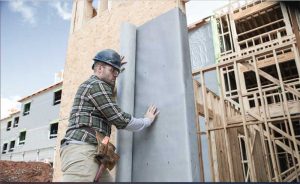Specifying the correct weather-resistant barrier
by sadia_badhon | September 25, 2020 9:08 am
 [1]
[1]by Bijan Mansouri
The importance of moisture management cannot be overstated. Water intrusion comes with the potential for moisture-related issues like mold and rot in the building envelope. Since the elusive ‘waterproof wall’ is yet to be invented, specifiers must turn their attention to effective moisture management strategies to best protect wall assemblies. Weather-resistant barriers (WRBs), also known as building wraps or housewraps, are one of the best building materials for controlling water, either through blocking rain from entering the wall cavity, allowing moisture vapor to move and escape the wall cavity, or draining bulk water away from the wall assembly.
Moisture management strategies impact all stakeholders in the design and building process. Specifiers want to be certain the material’s moisture management properties will support the performance of the envelope throughout the building’s lifespan, contractors need an installer-friendly and field-tested WRB, and architects should be certain cladding options will be compatible with the barrier.
Role of WRB in managing moisture
The main role of WRB is to protect the building envelope from bulk water, wind-driven rain, and water vapor. How does a WRB work against all three forms of intrusion? There are three primary defense mechanisms:
- water holdout for bulk water;
- drainability for rain penetration; and
- proper permanence or breathability for water vapor.
Water holdout for bulk water
As its most basic function, a WRB must hold out liquid water. A high-performance building wrap will be able to pass both ‘water ponding’ tests, which measure a building wrap’s resistance to a pond of 25-mm (1-in.) water over two hours, and a more stringent hydrostatic pressure test where the material is subjected to a pressurized column of water for five hours.
Drainability
A WRB is an effective material for keeping the wall assembly dry and reducing the potential for moisture damage. As the trend for tighter building assemblies continues to grow, building wraps have taken on a new function—removing trapped water from the wall assembly. The very latest innovations in housewrap technology are taking this moisture removal function one step further by incorporating drainage capabilities.
The drainage efficiency of a building wrap is generally tested in accordance with ASTM E2273, Standard Test Method for Determining the Drainage Efficiency of Exterior Insulation and Finish Systems (EIFS) Clad Wall Assemblies. In simple terms, this test involves spraying water on a wall assembly and measuring its collection over time. However, given the diversity of drainable building wraps on the market, the rate at which bulk water is drained varies a lot.
Today’s building wraps integrate drainage gaps into the material itself through creping, embossing, weaving, or filament spacers. These new technologies eliminate the need for furring strips, thereby helping to reduce material costs and streamline installation.
These new drainable building wraps meet all current code requirements for drainage efficiency (ASTM E2273) without sacrificing any of the durability and ease-of-installation benefits builders and contractors have come to expect from premium building wraps, since they essentially handle and install the same. They are also vapor permeable, so moisture will not get trapped in the wall assembly and cause mold or rot issues.
Permanence
A WRB must breathe to prevent moisture vapor from getting trapped in the wall cavity. Permeability measures the amount of vapor transmission a building wrap will allow over a period of time. For a product to be considered a WRB and not a vapor retarder, International Code Council (ICC) mandates the permeance rating must be higher than 5 perms. However, permeability can be achieved in a myriad of ways. For example, many low-grade housewraps achieve high perm ratings with mechanically punched perforations in the membrane. Conversely, more advanced non-perforated housewraps offer greater moisture vapor transmission (higher perms) than their perforated counterparts and are more effective at preventing the movement of bulk water.
In the paper, “Inward Drive – Outward Drying,” building scientist, Joseph Lstiburek recommends specifiers aim for the “sweet spot” of 10 to 20 perms to achieve the desired balance of moisture protection and breathability[2]. Achieving the optimal perm rating ensures that while water is prevented from entering the wall cavity, ideal levels of moisture vapor are still allowed to escape. Too high, he writes, and the moisture driven out of the back side of the reservoir cladding into the airspace will blow through the layer and the permeable sheathing and into the wall cavity. Too low, and the outward drying potential of the cavity is compromised. Thankfully, advances in building wrap technology are adapting to meet this need.
Material selection
An array of materials can be used as a WRB, but they are all not equal. When evaluating the potential effectiveness of a WRB, durability and the balance of holdout and permeability are critical factors.
Plastic building wraps
Plastic, nonwoven building wraps have been the most popular WRB for the last 40 years. Their effectiveness is rooted in their ability to shut out air and water, while simultaneously allowing walls to breathe. Typically made from polyethylene (PE) or polypropylene (PP) fabrics, synthetic housewraps are both lightweight and easy to install. In addition to boasting high-performance air and water holdout, plastic building wraps offer exceptional moisture vapor transmission, ultraviolet (UV) stability, and even increase the energy efficiency of the building.
When it comes to building wrap, ICC tests durability on two primary indicators: tensile strength and tear resistance. These factors are critical because the wrap needs to be able to stand up to the handling and installation process without compromising its water resistance.
Tear resistance, as measured by trapezoidal tear tests (ASTM D1117, Standard Guide For Evaluating Nonwoven Fabrics), is a good measure for predicting a building wrap’s ability to withstand the rigors of the jobsite and also to stay on the wall after installation. ‘In-plane’ is the best measurement of tear resistance. The trapezoid tear test, the best measurement of in-plane tear resistance, takes place when the building wrap is fastened to the wall and is subjected to tearing in the plane of the wall.
Some building wraps make claims about their tensile strength based on ASTM D882, Standard Test Method for Tensile Properties of Thin Plastic Sheeting, which is actually a test for thin plastic sheeting, and not nonwoven fabrics. Since the product is never used in this way, these measurements are not meaningful.
However, the grab tensile measurement is useful. ASTM D5034, Standard Test Method for Breaking Strength and Elongation of Textile Fabrics (Grab Test), tests a 1 x 2-m (4 x 6-ft) material sample and clearly says it is designed for nonwoven fabrics, making it a much better metric for evaluating building wraps.
Installers should also be cognizant of the product’s exposure time to the elements, since frigid temperatures and UV rays can cause cracking. High-performing building wraps have low-temperature resistance and built-in UV protection.
 [3]
[3]Asphalt felt paper
Asphalt felt paper[4] is an absorbent material made from a base of natural (wood) or synthetic (fiberglass) materials and an asphalt coating that can be used as a secondary layer of protection against moisture intrusion. The two most common types of asphalt felt are 15# and 30#. Ranging from 5 perms when dry to nearly 60 perms when wet, felt will absorb[5] water in humid conditions and dry to the exterior. However, there are several downsides to using felt paper. First and foremost, felt paper must be handled with extreme care to avoid tearing or ripping the delicate material. Tears and rips minimize the performance capabilities of WRBs by allowing water to build up in the wall system. Additionally, asphalt felt paper is prone to UV degradation from extended sunlight exposure. This exposure weakens the material, thereby compromising its durability. When combines with long-term heat aging, UV degradation can reduce the integrity of asphalt felt paper.
Impregnated sheathing
Impregnated sheathing is a relatively new weather barrier material composed of oriented strand board (OSB) wood structural sheathing panels that have an integrated WRB layer. These panels are typically fastened together with seam tape. The sealing tape[6] is a polyolefin sheet with an acrylic adhesive backing. While speed of installation and wind resistance are benefits of these materials, there are several setbacks associated with using impregnated sheathing as a WRB. For example, swelling along edges and corners is a well-cited issue among contractors. Swelling creates complications for taping[7] and can instigate pathways for air and water to enter the wall assembly. Careful attention during installation is also important with impregnated sheathing, since overdriven fasteners can open the system up for water penetration.
Furring strips
Before integrated drainage gaps were woven into the building wrap, contractors used furring strips as a capillary break to separate the wrap from the structural sheathing and framing. Today, wooden, metal, or plastic furring strips can be used to create a true plane on which to attach flat surface materials. The gap created by the strips allows water to flow down with gravity and drain out of the building envelope.
Rainscreens
One method for achieving bulk water drainage is attaching a rainscreen material to the building wrap. These products eliminate the cost and time-consuming labor of installing furring strips by creating a gap between the sheathing and the cladding, which facilitates both drainage and continuous airflow. Where wood strapping only vents approximately 85 percent of the wall, building wraps with an integrated rainscreen provide a continuous vented airspace over the entire surface area of the wall, providing greater drainage and more effective drying. Since many rainscreen products use a matrix of plastic material to achieve the gap, they are not subject to saturation and decomposition that could compromise wood furring.
Rainscreen products are recommended in areas with wind-driven rain, heavy rainfall (1016 to 1524 mm [40 to 60 in.] annually), or high temperature and humidity. Coastal areas and hilltops are suitable for this technology. In these situations, the importance of creating a drainage plane is heightened when using an absorptive cladding material like wood or fiber cement.
Other considerations
As a general rule, the Building Enclosure Moisture Management Institute (BEMMI) recommends any area receiving more than 508 mm (20 in.) of annual rainfall should incorporate enhanced drainage techniques in the wall system, especially if using an absorptive cladding material. Areas receiving more than 1016 mm of rain should utilize rainscreen design regardless of cladding material. The geographic orientation of the wall, amount of overhang, altitude, and even nearby trees can have an impact on the expected amount of water intrusion and how likely drying is.
Some states have added prescriptive measures to their codes that include the use of drainage planes, and others are expected to follow. Oregon, for example, requires the building envelope to consist of an exterior veneer, a WRB, a minimum 3-mm (1/8-in.) space between the WRB and the exterior veneer, and integrated flashings. The envelope must offer proper integration of flashings with the water-resistive barrier, the provided space, and exterior veneer. In lieu of providing the 3-mm space between the exterior veneer and WRB, builders can install the exterior veneer over a WRB that is manufactured to enhance drainage and meets the 75 percent drainage efficiency requirement of ASTM E2273 or other recognized national standards.
These considerations are driving the adoption of new WRB solutions that meet both bulk water blockage and drainage needs, thus satisfying the requirements for today’s high-performing wall systems.
Impact of siding selection
While there are many exterior cladding options on the market today, none of them are impervious to the effects of water penetration. Installing a water repellant material behind the cladding might be common sense, but knowing which type of WRB pairs best with which cladding is a little less obvious. There is a right and a wrong way to combine WRBs and claddings, and builders need to know each cladding material comes with a unique set of installation best practices for managing excess moisture.
For example, when installing vinyl siding, which has built-in drainage holes and fits loosely on the wall, an ordinary smooth-faced building wrap should provide adequate drainage. However, tightly fastened cladding, such as cedar siding or fiber cement board, might allow the water trapped between the siding and a smooth building wrap to pool. This could eventually make its way through the building wrap and into the framing. These are cases where a drainable building wrap would provide significant benefit.
Reservoir claddings such as brick, stucco, and stone present another set of issues. Since these materials hold water, once they get wet, the stored water can migrate elsewhere and cause problems. In these applications, it is imperative to separate the cladding from the rest of the assembly with a capillary break, which can be an airspace or a material that sheds water or does not absorb or pass moisture.
Also, certain cladding materials such as wood and stucco often contain chemicals called surfactants (or surface-active agents) that can affect the water resistance of WRBs. These chemicals, which are also present in solutions used to power-wash siding, reduce the surface tension of water, easing its ability to pass through microscopic openings in the membrane. So, if the WRB will be exposed to surfactants, it is advisable to choose a product that has added protection against their harmful effects.
One type of cladding gaining considerable attention is fiber-cement board. Strong, easy-to-install, and less expensive than wood cladding, fiber-cement board is an attractive option because it does not require any maintenance. The material is both fire- and insect-resistive and can even increase the building’s energy efficiency as part of a tight building envelope. On the flip side, since fiber-cement board is a tightly fastened cladding, it might allow water to get trapped between the siding and a smooth WRB. The water could eventually make its way through the wrap and into the framing.
Defending the structural integrity of a building is no easy feat, but with the right moisture management strategies, it is an attainable task. When looking at factors like durability and performance on the jobsite, weather-resistant barriers are an easy answer to many of the construction and comfort concerns presented by Mother Nature.
- [Image]: https://www.constructionspecifier.com/wp-content/uploads/2020/09/Image1-copy.jpg
- moisture protection and breathability: http://www.buildingscience.com/documents/digests/bsd-108-investigating-and-diagnosing-moisture-problems
- [Image]: https://www.constructionspecifier.com/wp-content/uploads/2020/09/Image2.jpg
- Asphalt felt paper: http://barricadebp.com/news/house-wrap-vs-felt-paper-which-is-the-better-wrb
- felt will absorb: http://barricadebp.com/news/house-wrap-vs-felt-paper-which-is-the-better-wrb
- sealing tape: https://www.qualitybuilt.com/resources/tech-alert-zip-system-vs-tyvek-homewrap-pros-and-cons/#:~:text=ZIP%20System%20%E2%80%93%20Description&text=The%20ZIP%20System%20includes%20two,%2Dimpregnated%20polymer%2Dmodified%20material
- complications for taping: https://www.qualitybuilt.com/resources/tech-alert-zip-system-vs-tyvek-homewrap-pros-and-cons/#:~:text=ZIP%20System%20%E2%80%93%20Description&text=The%20ZIP%20System%20includes%20two,%2Dimpregnated%20polymer%2Dmodified%20material
- [Image]: https://www.constructionspecifier.com/wp-content/uploads/2020/09/TYPAR_Bijan.jpg
- bijanmansouri@berryglobal.com: mailto:bijanmansouri@berryglobal.com
Source URL: https://www.constructionspecifier.com/specifying-the-correct-weather-resistant-barrier/
 [8]Bijan Mansouri is the technical manager at TYPAR Construction Products. He has been with Berry Plastics for 25 years, working in different technical capacities. Mansouri is responsible for building code requirements, design and development of new construction products, and education on proper practice and installation of building envelope. He received his bachelor’s and master’s degrees in mechanical/aerospace engineering and is a member of the Air Barrier Association of America (ABAA) and ASTM. He can be reached at bijanmansouri@berryglobal.com[9].
[8]Bijan Mansouri is the technical manager at TYPAR Construction Products. He has been with Berry Plastics for 25 years, working in different technical capacities. Mansouri is responsible for building code requirements, design and development of new construction products, and education on proper practice and installation of building envelope. He received his bachelor’s and master’s degrees in mechanical/aerospace engineering and is a member of the Air Barrier Association of America (ABAA) and ASTM. He can be reached at bijanmansouri@berryglobal.com[9].